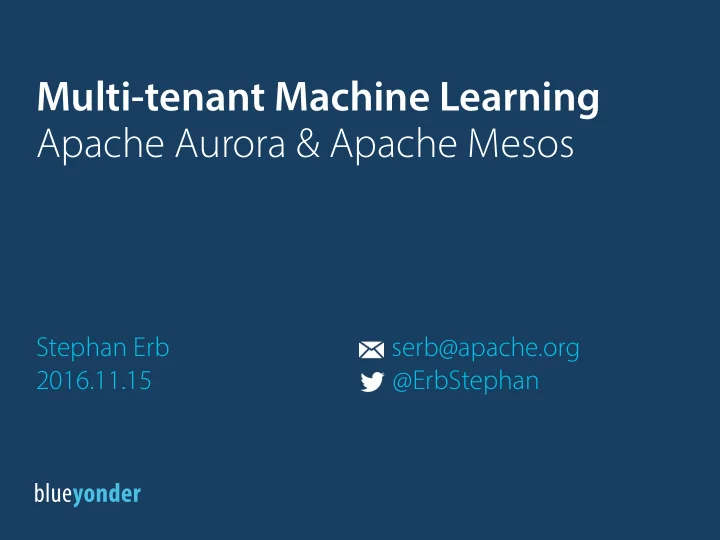

Multi-tenant Machine Learning Apache Aurora & Apache Mesos Stephan Erb serb@apache.org 2016.11.15 @ErbStephan
Apache Aurora https://aurora.apache.org Mesos framework for the deployment and scaling of stateless and fault tolerant services in a datacenter Apache Mesos https://mesos.apache.org Cluster manager providing fault-tolerant, fj ne-grained multitenancy via containers
Apache Aurora https://aurora.apache.org “distributed supervisord" Apache Mesos https://mesos.apache.org “plumbing”
Cluster Manager
Cluster Manager
Aurora Example webservice = Process ( name = 'webservice', cmdline = ‘./run_my_webservice.py’) task = Task ( processes = [webservice], resources = Resources(cpu=4, ram=4*GB, disk=8*GB)) jobs = [ Job ( task=task, instances=4, constraints = {'host': 'limit:1'}, service=True, cluster=‘rz1', role=‘www’, environment=‘prod’, name=‘webserver’), ]
Aurora Example $ aurora update start rz1/www/prod/webserver \ webserver.aurora
● ● Coordinator Node Aurora Scheduler Zookeeper Mesos Master State ● ● Worker Node Mesos Agent ● ● Task (Container) Aurora User Code Executor
Photo by liz west https:// fm ic.kr/p/7qYh21
● ● Customer System • Predictions Data Delivery • Decisions ● ● ● ● Tenant / ML model Tenant / ML model Historic Tenant Data Compute Platform
Key Achievement Data scientists deploy to production.
Key Achievement Data scientists deploy to production.
Key Achievement Data scientists deploy to production.
bigger VM/Host VM/Host
Data larger than RAM Implementation Choices: • semi- external implementation (out-of-core) • communication-e ffi cient distributed memory implementation • streaming (aka “large data volumes are hard, in fj nite data is easy”)
Data larger than RAM Implementation Choices: • semi- external implementation (out-of-core) • communication-e ffi cient distributed memory implementation • streaming (aka “large data volumes are hard, in fj nite data is easy”)
Domain-speci fj c Problem Decomposition # Compute on whole data set # compute_prediction(data) # Compute on partitioned data # # (this is rather restrictive but tends to # work great for many usecases) # for chunk in partition(data): compute_prediction(chunk)
Python Scheduling Master • manages job graphs • guarantees fault tolerance Workers • run python functions • distributable • dynamic worker count http://www.celeryproject.org/ http://distributed.readthedocs.io/en/latest/
Cluster Scheduling Project/ Tenant Compute Cluster
Cluster Scheduling Project/ Tenant Compute Cluster
Cluster Scheduling Project/ Tenant Compute Cluster
Key Idea Multi-tenancy via multi- instance deployments
Good multi-tenancy is hard enough that it just doesn’t happen by accident. — Jay Kreps https://www.con fm uent.io/blog/sharing-is-caring-multi-tenancy-in-distributed-data-systems
Multi-tenant Features Aurora Mesos • Structured job keys • Linux users • role (tenant01, …) • Filesystem isolation via • environments (devel, …) Docker/Appc containers • name • CPU/RAM isolation via • Job tiers/priorities cgroups • Linux namespaces (pid, • Quota & preemption network, …) • Multi-framework support
Merits and Pitfalls? Multiple frameworks on the same Mesos cluster
Feature Dimensions User Operator • long-running services • high-availability • maintenance primitives • cron jobs & adhoc jobs • resource quotas and • rolling job updates, with automatic rollback preemption • service announcement • instrumented for in ZooKeeper monitoring and • scheduling constraints debugging • oversubscription • Docker/Appc support • self-service UIs
Oversubscription https://github.com/blue-yonder/mesos-threshold-oversubscription
Executive Summary In this talk, we have seen: • Aurora & Mesos provide excellent support for heterogenous workloads. • They can even be used by data scientists to ship machine learning models into production. • All without major headache for your operations team.
Thank you! Stephan Erb serb@apache.org 2016.11.15 @ErbStephan
Recommend
More recommend